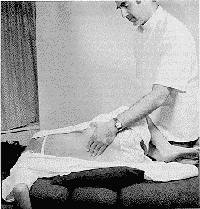Indirect Techniques. These methods, rather than engaging and attempting (by whatever means) to overcome resistance, do the opposite. In counterstrain technique, for example, the part in question is moved by the practitioner away from the planes of restricted motion towards the planes of easier, unrestricted motion. There is a constant seeking for the position of greatest ease. At this point a mild degree of strain is introduced by the operator. This results in a reflex release of previously restricted tissues. The essence of this slowly performed technique is the introduction of the mild strain, whilst the joint is held in a position opposite to the direction in which there is a limitation of movement. It is essential that all movements are directed and controlled by the practitioner, as he eases the joint along the path of least resistance.
A further type of indirect technique is called functional technique. This also uses practitioner induced movement, whilst the area of dysfunction is constantly palpated. The joint is taken in all directions of ease (as opposed to directions of bind, which indicate irritation of tissues) gradually guiding towards the point of maximum ease. The palpating hand informs the practitioner when the affected area is least in distress. There is no further treatment at this point. The feedback from the distressed joint whilst in its state of ease is enough to begin normalization.
 |
Shows the spontaneous release technique in which the affected part (in this case the low back) is carefully positioned in an exaggerated degree of the distortion already existing. This is maintained until there is a reflex release of spasm. No active manipulation is used at this usually acute stage. |
Spontaneous release technique is a method ideally used when an area or joint is in lesion and is distorting its normal anatomical position. Often in low back problems, or neck conditions, there will be an obvious distortion. The individual might be in a stooped position or tilted to one side, or be unable to straighten a sidebent neck. This technique gently guides the affected part further into the direction of distortion. By exaggerating the lesion and holding the area in this position for several minutes, there is often a reflex release of muscular spasm and a resolution of the problem. This is a painless method.
Many techniques employ the assistance of the respiratory movements of the patient. It is a fascinating fact that as we breathe in and out, every part of the body moves. Perhaps some of the movement is very slight indeed, but it is palpable to the trained hand. For example, as we breathe in, the arms and legs rotate slightly outwards, and all the spinal joints move. The opposite (i.e. a return to the neutral position) takes place as we breathe out. Using this knowledge an osteopath will often synchronize attempts to move a joint with the phase or the respiratory cycle that will most aid the movement.
Combinations of direct and indirect techniques, sometimes preceded or followed by soft tissue methods, are often employed. Whether one method or another or a combination is needed, will be dictated by the individual case. The wide range of techniques available (and those described are by no means all) gives the osteopathic practitioner the ability to deal with musculo-skeletal problems and their ramifications.